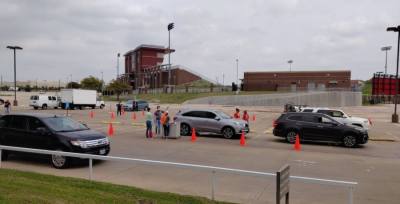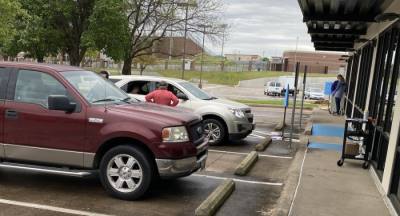With the district’s strategic plan and efforts from previous bond programs, every student in the district has a school-issued device, Executive Director of Communications Kristin Snively said. This helped make the transition to home-based learning one step easier, she said, but the district is also taking steps to maintain that connection. On March 27 the district launched curbside emergency repairs for student devices.
“Now that we've addressed devices in the hands of the kids and connectivity, we have to be able to address the fact and the reality that things are going to break,” GCISD Chief Technology Officer Kyle Berger said.
The district’s technology staff is working remotely through chat groups and emails to teachers and students to provide support online. But sometimes devices still need to be fixed as soon as possible, Berger said. That’s when the curbside repair service comes in.
This service is offered twice a week with appointments scheduled through the district’s technology staff. With curbside repairs, devices can be swapped out, charger cables can be delivered and staff can troubleshoot devices. The faculty member or student remains in the car, and technology staff work outside the vehicle in protective gear, Berger said.
“While we try to triage and still work through the problem, if this is your only means of a device, then we'll work on a plan to how we can swap that out for you or do the repair,” he said.
The full details of the curbside repair and how to schedule an appointment can be found here. This is a service the district had provided on a smaller scale during the summers when students needed assistance with devices, Berger said. The technology department was able to take the foundations for the program and ramp it up to meet the district’s larger need, he said.
In addition, in late March the district began broadening its Wi-Fi signal to allow the community to access the GCISD wireless network from the parking lots of campuses. People can connect to the internet from inside their vehicles and complete their work without having to use a password, Berger said. This is a free service to the community, and no GCISD-issued device is required.
“We're all in this together. It is filtered internet, so you're not gonna be able to watch Netflix and those kinds of things,” he said. “But you could pull up there and do your work if you need it.”
A list of the sites with the expanded Wi-Fi can be found here. Berger said GCISD is working with the cities of Grapevine and Colleyville to identify other Wi-Fi locations where people can possibly pull up in their car and connect to the internet while maintaining social distancing.
“Anytime we hit any kind of obstacle where we can’t get equipment or can’t connect, we're always going to try to find a way to overcome that,” Berger said.
GCISD teachers are continuing to educate students through the GCISD Learning@Home platform the district launched, Snively said. After a brief period of review, students began learning new content March 30 through this platform, Snively said.
Through these changes, Berger and his department have gone from providing support to just the campuses and buildings, about 22 locations, to supporting teachers’ and students’ homes directly, resulting in more than 12,000 locations, he said. It’s an essential part of providing an education, he said.
“The extra ability to do that video conferencing and connect face to face with your teacher or see your classmates is so vital—the look on the kids’ faces when they can all see each other again, that social interaction is so important,” Berger said. “We all know what it's like to be cooped up in your house and not see your friends. Now we can connect you in this online world to do that. That's been very important for us.”
Providing this support is something he and his team are able to do thanks to the technological foundation the district and the community have installed “to prepare for the future,” he said.
“The future is here, and it's a historic moment,” Berger said. “As a district and a community we’re able to rise together to really continue educating our students.”








